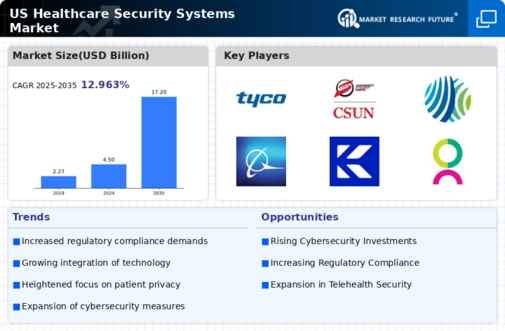Growing Demand for Patient Privacy
In the healthcare security-systems market, the increasing emphasis on patient privacy is a critical driver. With the implementation of regulations such as HIPAA, healthcare providers are mandated to protect patient information. Non-compliance can result in hefty fines, reaching up to $1.5 M per violation. As a result, healthcare organizations are prioritizing investments in security systems that ensure data protection and compliance with privacy regulations. This trend is further fueled by patients' growing awareness of their rights regarding personal health information. Consequently, the healthcare security-systems market is likely to see a surge in demand for solutions that enhance data security and maintain patient confidentiality.
Increasing Incidence of Healthcare Fraud
The healthcare security-systems market is experiencing growth due to the rising incidence of healthcare fraud in the US. Fraudulent activities, such as billing for services not rendered or upcoding, have led to significant financial losses, estimated at over $68 B annually. This alarming trend necessitates the implementation of robust security systems to safeguard against fraudulent claims and protect sensitive patient data. As healthcare organizations seek to mitigate these risks, investments in advanced security technologies are likely to increase. Consequently, the demand for comprehensive security solutions, including surveillance systems and access control measures, is expected to rise, driving the healthcare security-systems market forward.
Rising Awareness of Cybersecurity Threats
Rising awareness of cybersecurity threats is propelling the healthcare security systems market. With the increasing digitization of healthcare records, the risk of cyberattacks has escalated, leading to data breaches that can compromise sensitive patient information. In 2025 alone, healthcare organizations reported a 25% increase in cyber incidents compared to previous years. This heightened awareness has prompted healthcare providers to invest in comprehensive security systems that include cybersecurity measures. As organizations seek to protect their networks and data from potential breaches, the demand for integrated security solutions is expected to grow, thereby enhancing the healthcare security-systems market.
Regulatory Pressures and Compliance Requirements
Regulatory pressures and compliance requirements are driving the healthcare security-systems market. The US government has established stringent regulations aimed at protecting patient data and ensuring the security of healthcare facilities. Compliance with these regulations is not only mandatory but also essential for maintaining operational integrity. Failure to comply can result in severe penalties, including fines and loss of accreditation. As healthcare organizations strive to meet these regulatory demands, they are increasingly investing in security systems that facilitate compliance. This trend is likely to bolster the healthcare security-systems market, as organizations seek to implement solutions that align with regulatory standards and enhance overall security.
Technological Advancements in Security Solutions
The healthcare security-systems market is significantly influenced by technological advancements in security solutions. Innovations such as artificial intelligence (AI) and machine learning are being integrated into security systems to enhance threat detection and response capabilities. For instance, AI-driven surveillance systems can analyze video feeds in real-time, identifying suspicious activities and alerting security personnel. The market for these advanced security technologies is projected to grow at a CAGR of 10.5% through 2027. As healthcare organizations increasingly adopt these cutting-edge solutions, the healthcare security-systems market is poised for substantial growth, driven by the need for more effective and efficient security measures.

















Leave a Comment